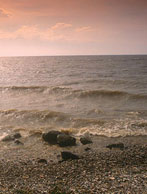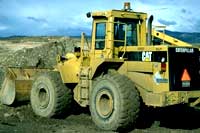
News |
- Environmental Group Tours Hydro-Affected Community
- Report Slams Hecla Resettlement
- Action on Ontario's Living Legacy
- Texas Wind Blows With Green Power
- Report Released: Clean Up Winnipeg Wastewater System
- Wuskwatim Hearings Schedule Delayed
- Lake Winnipeg Stewardship Board Named
- Lowlands National Park Needs Protection
- Mining Task Force Report Released
- Fish In The Sea, But For How Long?
- Brandon/Maple Leaf Foods License Hearings Extended
- Canadians Support Boreal Forest Conservation - Poll
Environmental Group Tours Hydro-Affected Community |
18 September 03 |
 Three members of the Minnesota group Minnesotans for an Energy-Efficient Economy (ME3) toured South Indian Lake in late August, along with representatives of Winnipeg's Boreal Forest Network, to hear about lingering problems from construction of northern hydro dams. Three members of the Minnesota group Minnesotans for an Energy-Efficient Economy (ME3) toured South Indian Lake in late August, along with representatives of Winnipeg's Boreal Forest Network, to hear about lingering problems from construction of northern hydro dams. South Indian Lake is calling on Manitoba Hydro and governments to address the impacts of past hydro developments on their community before new projects, such as the proposed Wuskwatim dam currently under review, are approved. ME3 supports the efforts of communities such as South Indian Lake to secure compensation for past hydro developments, which continue to have environmental and social consequences. Don Sullivan, coordintor of the Boreal Forest Network participated in the recent tour. He told manitobawildlands.org "My brief visit to the community of South Indian Lake and my conversations with many elders left me with the distinct impression that Manitoba Hydro is avoiding, at all costs, honouring its debt to that community. It's tantamount to "environmental racism" and in this day and age there is no room for this type of egregious behavior." ME3 is a non-profit organization working for a phased-in adoption of clean energy technologies. Manitoba Hydro is a focus of activities by the organization because Minnesota utilities (primarily Xcel Energy) purchase 40 percent of Manitoba Hydro out-put and sell it to customers in the U.S. The objective of JustEnergy, an ME3 campaign, is to educate consumers about the impacts of Manitoba Hydro's large-scale dams on people and the environment in northern Manitoba. ME3 aims for Xcel Energy, regulators, and legislators to set standards for hydropower purchased by utilities and sold to Minnesota consumers so that no harm to people or the environment occurs. Visit the ME3 web site Visit the JustEnergy web site Sources: Winnipeg Free Press, ME3, JustEnergy |
|
Report Slams Hecla Resettlement |
9 September 03 |
 Manitoba's Auditor General has released a scathing report on the way property was handled during the resettlement of Hecla Island. Hecla is a historic Icelandic settlement whose residents were forced out in 1969 to make way for Hecla provincial park. Manitoba's Auditor General has released a scathing report on the way property was handled during the resettlement of Hecla Island. Hecla is a historic Icelandic settlement whose residents were forced out in 1969 to make way for Hecla provincial park. Jon Singleton's report is in response to allegations made by former Hecla landowners critical of the government and officials responsible for parceling out land that had been expropriated years earlier. Singleton said the process used to decide who would get a cottage lot was not well managed or fair, and procedures were so flawed that there may have been criminal actions on the part of some public officials. The Auditor General forwarded six cases to the provincial Justice Department, recommending criminal investigation. He also recommends redress for former Hecla residents who were unfairly denied the chance to get property. Manitoba accepts Singleton's findings, and will act on all his recommendations. View the Auditor General's report Sources: CBC.ca, Winnipeg Free Press |
|
Action on Ontario's Living Legacy |
8 September 03 |
 Four years after the 1999 Ontario Living Legacy Land Use Strategy (OLL), the government of Ontario is making significant progress toward finalizing the system of protected areas under OLL. Four years after the 1999 Ontario Living Legacy Land Use Strategy (OLL), the government of Ontario is making significant progress toward finalizing the system of protected areas under OLL. As of June 2003, the count of sites under formal protection has increased to 274, for a total of approximately 73% of the total 378 OLL sites. Roughly 64% of the 2.4 million hectares covered by the 378 sites is now formally protected. The regulation of these areas was facilitated in part by the resolution of overlapping mining claims through a cooperative process developed by the Ontario Prospectors Association and the Partnership for Public Lands. In other cases, the completion of local consultations on boundary refinements allowed the sites to move forward for Cabinet approval. It is anticipated that the remainder of the 378 sites will be approved within the year. There remains some uncertainty about the future of the protected areas as the Crown lands of Ontario come under increasing development pressure. This recent progress toward regulation demonstrates a commitment to comply with the 1999 Land Use Strategy blueprint and complete the OLL provincial protected areas system as promised. This is good news for nature in Ontario! The Partnership for Public Lands includes: the Federation of Ontario Naturalists, the Wildlands League - a chapter of the Canadian Parks & Wilderness Society (CPAWS), and the World Wildlife Fund Canada.
View the original WildOntario.org article |
|
Report Released: Clean Up Winnipeg Wastewater System |
26 August 2003 |
 A Manitoba Clean Environment Commission (CEC) report released August 20, 2003, made 20 recommendations to reduce amounts of pollutants and contaminants discharged into the Red and Assiniboine rivers. The Minister of Conservation requested this report to provide the province of Manitoba with advice and recommendations based on evidence presented at the public hearings held by the CEC. The report, 'Better Treatment - Taking Action to Improve Water Quality', contains advice and recommendations to alleviate and diminish the discharges that are destroying Lake Winnipeg, Manitoba's No. 1 recreation and tourism resource. A Manitoba Clean Environment Commission (CEC) report released August 20, 2003, made 20 recommendations to reduce amounts of pollutants and contaminants discharged into the Red and Assiniboine rivers. The Minister of Conservation requested this report to provide the province of Manitoba with advice and recommendations based on evidence presented at the public hearings held by the CEC. The report, 'Better Treatment - Taking Action to Improve Water Quality', contains advice and recommendations to alleviate and diminish the discharges that are destroying Lake Winnipeg, Manitoba's No. 1 recreation and tourism resource.Included in the lengthy list, the report focused on two main recommendations:
All other "point sources" contribute twice as great a load of nutrients to the lake as the city, and half the nutrients flowing into Lake Winnipeg come from the United States. Every major centre in the Nelson watershed, from Grand Forks to Edmonton, already controls effluents more strictly than Winnipeg and Manitoba. View or download the full report Sources: Winnipeg Free Press, Manitoba Clean Environment Commission (CEC) |
|
Wuskwatim Hearings Schedule Delayed |
14 August 2003 |
 On August 7th, 2003, the Manitoba Clean Environment Commission (CEC) decided to reschedule the pre-hearing process for the Wuskwatim Generation and Transmission Project. "...The schedule for the pre-hearing process as proposed by Manitoba Hydro/Nisichawayasihk Cree Nation will not provide sufficient time for all of the interested participants to fairly and reasonably prepare for participation in the public hearing." Currently the CEC is considering submissions from public participants regarding the hearing schedule. No final decisions on scheduling or scope will be finalized until the Motion filed by Pimicikamak Cree Nation has been considered. On August 7th, 2003, the Manitoba Clean Environment Commission (CEC) decided to reschedule the pre-hearing process for the Wuskwatim Generation and Transmission Project. "...The schedule for the pre-hearing process as proposed by Manitoba Hydro/Nisichawayasihk Cree Nation will not provide sufficient time for all of the interested participants to fairly and reasonably prepare for participation in the public hearing." Currently the CEC is considering submissions from public participants regarding the hearing schedule. No final decisions on scheduling or scope will be finalized until the Motion filed by Pimicikamak Cree Nation has been considered.Despite the CEC ruling - the August 9, 2003 Winnipeg Free Press carried public notice of Manitoba Hydro's water power license application for the Wuskwatim projects. This application assumes the licensing and construction schedule proposed by Manitoba Hydro is still in place. Manitoba water power licenses are not reviewed under the Environment Act. View the CEC August 7, 2003 ruling click here View the Winnipeg Free Press August 9, 2003 public notice, click here |
|
Lake Winnipeg Stewardship Board Named |
12 August 2003 |
 An initiative to save Lake Winnipeg from the effects of increasing phosphorus and nitrogen levels moved ahead July 18, 2003 with the official announcement of members appointed to the Lake Winnipeg Stewardship Board. An initiative to save Lake Winnipeg from the effects of increasing phosphorus and nitrogen levels moved ahead July 18, 2003 with the official announcement of members appointed to the Lake Winnipeg Stewardship Board. "This board will provide valuable direction to take further actions necessary to help ensure the future protection of the world’s 10th largest freshwater body of water," said Conservation Minister Steve Ashton. "As a unique home for fish and organisms, Lake Winnipeg provides a 24,000-square-kilometre area for recreation and commercial uses such as fishing, boating and angling," said Ashton. "A long-term commitment to everyone with a vested interest in water quality will ensure the success of the board’s work." The first task of the new board, under chair Bill Barlow, will be to establish operating rules and prioritize a variety of issues affecting the health of Lake Winnipeg. The board will also start on implementation of a riparian protection action plan to help address effects of tillage and grazing by livestock on lands adjacent to streams and rivers, including shoreline erosion. View the press release |
|
Lowlands National Park Needs Protection |
30 July 2003 | ||
 In a fall 2002 letter to the Prime Minister, Manitoba Premier Gary Doer promised to take essential steps to establish Manitoba's third national park in the lowlands between Lake Winnipeg and Lake Winnipegosis, at Long Point and Limestone Bay. The Lowlands national park has been under study since the 1970's. Canadian Nature Federation technical reports during the 1990's identified ecological deficiencies in the Government determined boundaries and recommended significant expansion of the protected lands intended. Ecological integrity can be increased, with community consent, once interim protection is in place for Long Point and Limestone. In a fall 2002 letter to the Prime Minister, Manitoba Premier Gary Doer promised to take essential steps to establish Manitoba's third national park in the lowlands between Lake Winnipeg and Lake Winnipegosis, at Long Point and Limestone Bay. The Lowlands national park has been under study since the 1970's. Canadian Nature Federation technical reports during the 1990's identified ecological deficiencies in the Government determined boundaries and recommended significant expansion of the protected lands intended. Ecological integrity can be increased, with community consent, once interim protection is in place for Long Point and Limestone.Today, ten years after the government memorandum of understanding (MOU), no part of this future national park is protected land. Manitoba provided interim protection for Wapusk national park, established on Hudson Bay during the 1990s. The lands were secure during negotiations and consultations. First Nation communities affected by the Lowlands national park are essential decision makers in this process. View CNF's Ten Most Wanted Parks & Manitoba Lowlands For more Manitoba information, go to our Protected Areas page
|
|||
Mining Task Force Report Released |
25 July 2003 |
 Manitoba convened the Mining Task Force to gather stakeholder and community input on the future direction of the mining and petroleum sectors, and the role government has to play in maintaining the viability of these sectors. The Mining Task Force heard dozens of presentations from stakeholders. Manitoba convened the Mining Task Force to gather stakeholder and community input on the future direction of the mining and petroleum sectors, and the role government has to play in maintaining the viability of these sectors. The Mining Task Force heard dozens of presentations from stakeholders.The Task Force comprised 4 government members of the legislature: Gerard Jennissen (Flin Flon), Doug Martindale (Burrows), Tom Nevakshonoff (Interlake) and Harry Schellenberg, (Rossmere). Consultations were held in Winnipeg, and five other Manitoba communities. The Minister of Industry, Trade and Mines has agreed to consider these recommendations as a guide to future planning activities for the department. Included are specific recommendations regarding protected areas establishment in Manitoba. The report urges Manitoba to speed up decisions regarding the 3.6 million hectares the mining industry has endorsed for permanent protection. View the Mining Task Force web site Download the Mining Task Force Final Report (PDF 68KB) |
|
Fish In The Sea, But For How Long? |
25 July 2003 |
 A July 2003 review of marine fisheries released by the Earth Policy Institute concluded that a startling 90 percent of the world's large predatory fish, including tuna, swordfish, cod, halibut, and flounder, have disappeared in the past 50 years. This 10-year study by Ransom Myers and Boris Worm at Canada's Dalhousie University attributes the decline to a growing demand for seafood, coupled with an expanding global fleet of technologically efficient boats. A July 2003 review of marine fisheries released by the Earth Policy Institute concluded that a startling 90 percent of the world's large predatory fish, including tuna, swordfish, cod, halibut, and flounder, have disappeared in the past 50 years. This 10-year study by Ransom Myers and Boris Worm at Canada's Dalhousie University attributes the decline to a growing demand for seafood, coupled with an expanding global fleet of technologically efficient boats.Three quarters of the world's oceanic fisheries are being fished at or beyond their sustainable yields according to The United Nations Food and Agriculture Organization (FAO). Trawlers indiscriminately drag enormous nets over a vast area, virtually clear cutting the seabed, destroying marine habitat, and taking up untargeted species. Worldwide, almost one fourth of the fish catch is discarded dead at sea, either because the fish are not marketable or because fishers have exceeded their catch allotment. Whales, dolphins, and porpoises also become part of this collateral damage. The capacity of the world's fishing fleet is now double the sustainable yield of fisheries. Myers and Worm from Dalhousie University believe that the global fish catch may need to be cut in half to prevent additional collapses. A redirection of annual fishing industry subsidies of at least $15 billion to alternatives such as the retraining of fishers could provide a big payoff. Once fisheries collapse, there is no guarantee they will recover. For more information go to Earth-policy.org Source: Original Article by Janet Larsen, Earth Policy Intitute |
|
Brandon/Maple Leaf Foods License Hearings Extended |
8 July 2003 |
 In March 2003, the City of Brandon submitted an Environment Act Proposal to Manitoba Conservation for an expansion to their existing Industrial Wastewater Treatment Facility (IWWTF). A Notice of Alteration from Maple Leaf Foods Inc. for their existing hog processing plant in Brandon was also submitted. Maple Leaf's expansion necessitates the Brandon wastewater treatment expansion. In March 2003, the City of Brandon submitted an Environment Act Proposal to Manitoba Conservation for an expansion to their existing Industrial Wastewater Treatment Facility (IWWTF). A Notice of Alteration from Maple Leaf Foods Inc. for their existing hog processing plant in Brandon was also submitted. Maple Leaf's expansion necessitates the Brandon wastewater treatment expansion.
The Manitoba Clean Environment Commission (CEC) was directed by the Minster of Conservation to conduct a public hearing to consider the proposal from the City of Brandon and to receive public comments and concerns respecting the wastewater treatment expansion proposal. On June 26, 2003, the CEC issued a precedent setting statement acknowledging that the licensing of the City of Brandon proposal was likely to result in an increased level of hog production in Manitoba and therefore potentially create environmental impacts. The CEC recognized that consideration of the potential environmental impacts of increased hog production in Manitoba, as it relates to the Proposal by the City of Brandon and the Notice of Alteration by Maple Leaf Foods Inc., is appropriate and necessary for the hearings. "[T]he Commission has concluded that the presentation of evidence and cross examination respecting the environmental impact of hog production in Manitoba, as it relates to this proposed development, will be allowed during the course of these proceedings", (hearing summary for June 25-27, 2003). The CEC hearings will reconvene July 15, 2003. Its report to Manitoba's Minister of Conservation will potentially include licensing recommendations not included when the Maple Leaf plant was licensed in 1999. Visit the Manitoba CEC web site |
|
Canadians Support Boreal Forest Conservation - Poll |
3 July 2003 |
 Canadians express strong support for making conservation a priority in Canada's Boreal forest ecosystem, according to a June 17, 2003 poll commissioned by the Canadian Boreal Initiative. Canadians express strong support for making conservation a priority in Canada's Boreal forest ecosystem, according to a June 17, 2003 poll commissioned by the Canadian Boreal Initiative. "Canada's boreal forest region is home to one of the world's last major intact forest ecosystems and covers more than half of Canada," says Cathy Wilkinson, CBI Director. "More than 30% of the region has already been allocated for resource development. Decisions about large-scale development proposals will soon be made in virtually every boreal province and territory," says Wilkinson. Asked whether conservation or economic development should be the priority in the Boreal forest region of Canada, seven in ten (71%) Canadians say that conservation should come first. The 2003 survey also found that:
These are among the findings of opinion research conducted recently for the Canadian Boreal Initiative by McAllister Opinion Research. The findings are based on a national phone survey of 1007 Canadians in February 2003, with a margin of error of 3.1%, 19 times out of 20. |
|


 RSS Feeds:
RSS Feeds: Texas, a state famous for its love affair with fossil fuels, has quietly begun a courtship with wind power that could push it to the United States' forefront in clean energy. Prodded by state laws that require utilities to purchase green credits, tax breaks and easy access to vast open plains with steady, strong winds, Texas has become the second-largest wind producer in the United States, after California.
Texas, a state famous for its love affair with fossil fuels, has quietly begun a courtship with wind power that could push it to the United States' forefront in clean energy. Prodded by state laws that require utilities to purchase green credits, tax breaks and easy access to vast open plains with steady, strong winds, Texas has become the second-largest wind producer in the United States, after California. 
